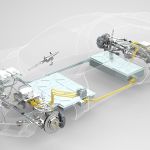Daimler Trucks and Waymo announced today that they have established a strategic partnership to deploy autonomous SAE Level 4 technology. The first step is combining Waymo’s automated driver technology with a version of Daimler’s Freightliner Cascadia to enable autonomous driving.
Waymo brings over a decade of work building what it calls the “World’s Most Experienced Driver,” having driven over 20 million miles on public roads across 25 U.S. cities and 15 billion miles in simulation. Daimler Trucks North America, Daimler’s U.S. truck subsidiary and parent company of the Freightliner brand, provides its experience developing class-leading Class 8 vehicles.
“We have the highest regard for Daimler’s engineering skills and broad global truck product portfolio, and so we look forward to scaling the Waymo Driver, together with our new partner, to improve road safety and logistics efficiency on the world’s roadways,” said John Krafcik, CEO, Waymo.
“The combination of increased road freight volumes, and the need and vision of fleet operators for highly automated trucks, is what fuels our relentless pursuit of innovation,” added Roger Nielsen, Member of the Board of Management of Daimler Truck AG, President and CEO of Daimler Trucks North America LLC. “Based on our collaboration with Waymo, we will be in the unique position to be able to provide our fleet customers with a choice among the best solutions for their individual requirements.”
Waymo and Daimler Trucks share a common goal of improving road safety and efficiency for fleet customers. They say that the autonomous Cascadia truck, equipped with the Waymo Driver, will be available to customers in the U.S. “in the coming years.” And they intend to investigate expansion to other markets and brands “in the near future.”
In recent years, Daimler Trucks says it has achieved significant progress on its global roadmap to bringing series-produced highly automated trucks to the road.
“With our strategic partnership with Waymo as the leader in autonomous driving, we are taking another important step towards that goal,” said Martin Daum, Chairman of the Board of Management of Daimler Truck AG and Member of the Board of Management of Daimler AG. “This partnership complements Daimler Trucks’ dual strategy approach, of working with two strong partners to deliver autonomous L4 solutions that are seamlessly integrated with our best-in-class trucks, to our customers.”
That other partner is Torc Robotics, the recent Daimler Trucks’ acquisition.
Earlier in October, Torc and Daimler announced they will scale up their self-driving truck testing in early 2021. The latest generation Cascadia test truck bolsters Torc’s capability to develop and test its Level 4 self-driving technology.
The test trucks are the second iteration of trucks jointly developed by the trucking and technology companies. The partners say that the ultimate goal is to reinvent the truck with safety-critical redundancy components as well as seamless integration of additional computes and hardware required for self-driving technology.
“To meet the redundancy and performance requirements of a self-driving truck, the traditional truck chassis must be reinvented,” said Michael Fleming, Torc’s CEO. “Just like any major innovation, it requires a stair-step approach toward the final product. We are taking this one step at a time, with safety as our guiding principle.”
Torc has been developing its self-driving technology for heavy-duty applications for more than a dozen years.
“We knew from the outset that self-driving technology cannot be commercialized without an OEM. In trucking, there are only a handful of OEMs, and we were fortunate to join the industry leader,” Fleming said of Daimler.
The goal of the effort to develop Level 4 integrated trucks must be to provide true customer value, added Nielsen.
Market-ready self-driving trucks must emulate the actions of the most experienced and safe truck drivers. The partners are developing software and hardware to reliably handle failures of safety-critical vehicle components such as braking, steering, power distribution, and messaging. The team is working to replicate is the way experienced truck drivers are able to feel component failures.
“Our software engineers are working with highly skilled truck drivers to understand this experience and transition this human intuition into embedded sensors and algorithms,” Fleming said.
Other Daimler Trucks news…














































































